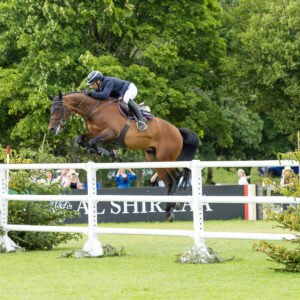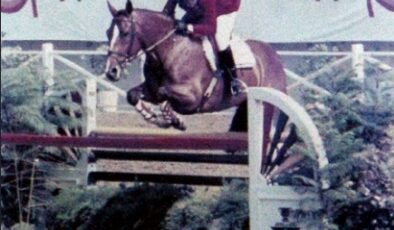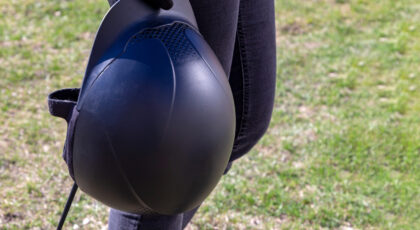As Danielle Goldstein and Lizziemary soared over the final Longines oxer during the jump-off round of the $71,200 Suncast Palm Beach Masters World Cup Qualifier in February, a gaggle of photo shutters clicked and chattered along the rail.
The pair’s flawlessly executed track and powerful athleticism would ultimately earn them second place in tough company, but the photographers had a different goal in mind: a coveted shot of Danielle’s famed, feathered locks.

©Kathy Russell Photography
The Israeli rider’s larger-than-life quilled extensions have grown in both hue and scale since she first adopted them more than a year ago. Her current style—a yellow, red, and orange confection that leaps and streams in the wind behind her like the tail of a flaming arrow—has become a favorite topic among equestrian media outlets, commentators, and the show jumper’s loyal fans. Ever an individual, Goldstein’s phoenix-like adornments are the quintessential accessory: a wildly creative extension of herself.
At least, that’s what you thought they were for.
“Hair feathers are fun, fashionable, and they certainly make a statement. But more than that, they can be an invaluable asset to a horse and rider in a critical moment of the jumping process,” explains Dr. Wilhelm Camp, a professor of Theoretical Physics at University College Dublin.
Dr. Camp has spent the last year studying Goldstein’s performances with Lizziemary at CSI events around the globe, recording the pair’s faults per round, average speed across the ground, and time in the air during critical moments on course. Dr. Camp compared Goldstein’s rounds, pre-feathers, with her rides now fully downed. The results shocked him.
“I can tell you, without a shadow of a doubt, that hair feathers are a competitive advantage,” Dr. Camp says. “My finding is that the feathers assist Danielle and Lizziemary during a critical moment in the arc of their jump, adding just enough lift to improve their average number of clears per year by nearly 32 percent.”

©Kathy Russell Photography
Whether or not Goldstein is aware of her competitive boon remains to be seen, but the evolution of her feathers—at least from a style perspective—has been a gradual progression.
“I had pink hair, and then I had blue hair, and I was trying to think of what I wanted to do next. I wanted to do something fun,” Danielle reported to Equestrian Living last spring. “We were looking at pictures of extensions and things and I saw a feather, and I thought, What if I put feathers in?”
Goldstein has said that she crafts her own extensions using more than 500 individual feathers purchased throughout her travels in Europe and New York City. But what began as a few stray quills woven into her braids back in September 2017, has since metamorphosed into full-fledged plumage.
Interestingly, during that same period, Danielle’s position on the Longines FEI Rankings List has also undergone a dramatic transformation: from 177th position in the fall of 2017 when she first adopted her feathers, to #43 in the world as of February, 2019. For those without a calculator handy, that’s an improvement of nearly 135 spots.
Happy coincidence or well orchestrated competitive planning? Dr. Camp has reached his own conclusion.
“There’s no doubt in my mind that the lift presented by these feathers is dramatically increasing Danielle Goldstein’s performance, and Lizziemary’s as well. I wouldn’t be surprised if other riders begin to catch on, and quickly. That is, I suppose, until the FEI reads my research brief [laughs]!”
The FEI has yet to comment on this issue, but other riders are certainly catching wind. Italy’s Lorenzo de Luca has been spotted taking Danielle’s own extensions out for a spin, and Goldstein appears to have taken her teammate on Team Israel, Ashlee Bond, under her wing. Bond has been undergoing her own hair transformation as of late, and it seems likely that she and fellow teammate, Daniel Bluman, may be cantering through the timers fully plumed someday soon.
Might that “someday” be just in time for an Olympic Team run at Tokyo in 2020? Only time will tell. But when it comes to feathered locks in the show jumping arena, one thing is clear: what’s good for the goose is almost certainly good for the gander.


 February 15, 2019
February 15, 2019 

























